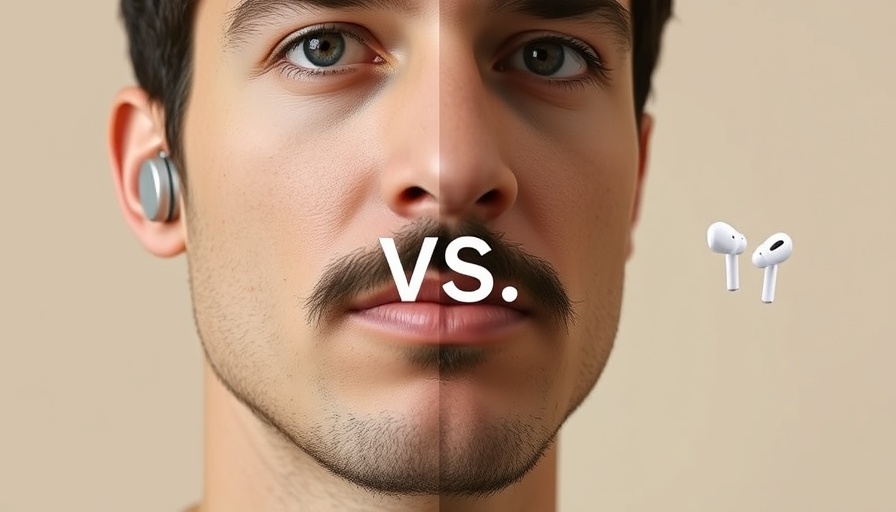
Understanding the Battle: Nothing Headphone 1 vs. AirPods Max
When it comes to choosing the right over-ear ANC (Active Noise Cancelling) headphones, the market is ripe with options, creating a daunting landscape for consumers. Among the most talked-about contenders are Apple’s AirPods Max and Nothing's Headphone 1. Apple sets a high bar, often being considered the gold standard for quality and user experience, particularly for those entrenched within their ecosystem. Yet, with a significant price difference of $250, many are now questioning the additional benefits of the more luxurious Apple offering compared to Nothing's eye-catching, budget-friendly alternative.
Aesthetic Appeal: Design Differences That Matter
First impressions matter, especially when it comes to consumer products. The design of both headphone models could not be more divergent. The AirPods Max sport a minimalistic, refined appearance utilizing premium materials like stainless steel and anodized aluminum. These attributes lend the AirPods a hefty and substantial feel, aimed at the upscale consumer.
In contrast, Nothing's Headphone 1 brings an element of nostalgia, designed with inspiration from retro cassette tapes. While this design might cater to a younger demographic or the style-conscious, it does utilize lighter materials, blending plastic with aluminum. Weighing in at 329g vs. AirPods Max’s 385g, the lightweight nature of Headphone 1 appeals to those who prioritize comfort on long listening sessions.
Functionality: Buttons Galore Versus Minimalist Control
Another contentious point is functionality. The Nothing Headphone 1 boasts a more interactive interface with multiple physical buttons, including a dedicated track skip, rewind, and volume control roller. Complemented by an on/off switch, this feature set allows users to navigate audio settings swiftly. It’s a refreshing change in a tech landscape that often favors minimalism, even at the cost of usability.
Conversely, the AirPods Max, while offering a sleek crown that controls volume and playback, lack an essential on/off switch, leaving some users frustrated. This design choice epitomizes Apple's ethos of simplicity but raises questions about user-centric design, especially for audiophiles who prefer tactile feedback.
Sound Quality: A Detailed Comparison
While aesthetics and functionality play critical roles, sound quality remains paramount. Both over-ear headphones promise rich sound experiences, but how do they stack up?
The AirPods Max are designed with Apple's computational audio technology, promising an immersive listening experience marked by clear highs and deep lows. Adaptive EQ optimizes sound based on the fit and seal of the ear cushions, representing a significant technical advantage. On the other hand, the Nothing Headphone 1 has been praised for its surprisingly rich audio quality, especially considering its price point. Understanding the nuances of bass response, clarity, and sound staging will greatly influence the choice between these two.
Long-Term Considerations: What Does Your Budget Allow?
Price and usability inevitably dominate the conversation around consumer tech. At $300, Nothing Headphone 1 appeals to consumers seeking value without skimping on style or basic functionality. This is critical as more people seek to balance budget constraints with quality, especially amid an ever-changing economy where smart choices are vital.
On the other hand, will the $550 investment in AirPods Max translate into long-term satisfaction? For users who are deeply entrenched in Apple’s ecosystem, seamless connectivity and superior sound quality may justify the expense. At the same time, others might find that branding alone doesn’t equate to superior performance.
Consumer Insights: What Do the Numbers Say?
According to various consumer reviews, a growing trend shows headphone shoppers prioritizing value-driven decisions. Research indicates that 65% of consumers are now more willing to test less-known brands if they can deliver quality comparable to that of established names. This shift may be bolstered by social media, where influencers and user-generated content drive engagement and clarify misconceptions.
Reviews suggest that while AirPods Max retain a loyal following, brands like Nothing are rapidly gaining traction among younger demographics who value aesthetic diversity and innovation without the premium price tag.
Final Thoughts and Decisions: Choosing Your Ideal Headphones
In the end, selecting between Nothing Headphone 1 and AirPods Max boils down to what consumers value most: sound quality, style, interface, and budget. For those seeking statement pieces without breaking the bank, Nothing presents an alluring option with varied functionalities that cater to a modern audience. In contrast, the AirPods Max offer a refined experience rooted in sophistication and quality that, though expensive, is embraced by Apple loyalists.
Technology enthusiasts should carefully consider their needs and financial capability before making a purchase. Instead of focusing solely on brand prestige, we encourage you to assess how each set of headphones aligns with your personal preferences and lifestyle.
 Add Row
Add Row  Add
Add 




Write A Comment